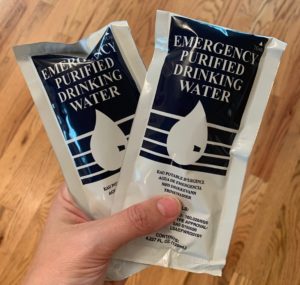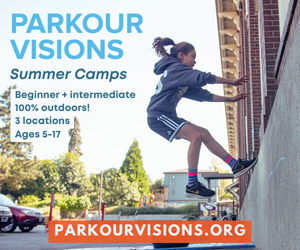Most of us have heard of The Big One, the doomsday term given to a long-overdue earthquake expected to hit the Pacific Northwest some time in the next 50 years. Those with school-age kids are likely familiar with earthquake kits, often requested by administrators at the start of the school year. But for many of us, that’s where our knowledge of earthquake preparedness ends.
For years, I didn’t think much beyond the Ziploc bag of non-perishable food because it was just easier to push those thoughts out of my mind. However, when I had the opportunity to attend a talk given by Parents4Preparedness, an organization that addresses earthquake preparedness in local schools, I decided to attend the free event, and what I learned that day surprised me.

What I had been hoping for was a simple recipe of things to buy to make the perfect kit so I could handily check “Prepare for an earthquake” off my never-ending mama to-do list. Easy.
Instead, the presenter focused on a handful of to-dos extending far beyond putting the right things in a bag. And while the steps she outlined take a bit more effort than adding items to one’s Amazon cart, most are applicable to any other sort of community emergency: fires, terrorist attacks, floods, etc. Seeing things in this light made me feel much less like a Crazy Earthquake Lady when I went about my prep, and more like someone who has done her due diligence for an array of potential disasters.
Below are some basic steps to begin preparation as a family:
Make a Plan and Practice with Your Kids
Many in the region don’t know basic earthquake safety rules; prepare your mind ahead of time so you know what to do. Share with your kids that the first step is to drop, cover, and HOLD ON. Get under a piece of sturdy furniture, if able, and hold on to it until the shaking stops. If you are outside, move away from buildings, as most injuries occur due to falling debris, glass, or other objects. Review these basic safety steps with your kids.
We live in a city bifurcated by a river. What would happen if a family member were to be stuck on the other side? Communication systems and cell service will likely be disrupted. Develop a reunification plan addressing how you will find one another in case of a disaster. If your kids are old enough, talk with them about emergency contacts and determine at least two meeting places where you can find one another were you to get separated and unable to communicate.
Meet your neighbors and get awkward (i.e. ask for their info)
I’m friendly with most of my neighbors, but that’s not the same as knowing what their needs may be in case of an emergency. Make a map of your neighborhood and get names and phone numbers. Ask about any concerns your neighbors might have were there to be a disaster and they couldn’t return home. Maybe your neighbor cares for his ailing mother who lives six blocks away. Maybe your other neighbor has pets they worry would get out. Is there anybody with mobility concerns or other health conditions that could be an issue during a disaster? Find out and write it down. By connecting with one another ahead of time, we can rely on each other before fire, medical, or police responders arrive. Earthquake or not, it’s good to know these things about your neighbors for any emergency.
Some choose to organize a neighborhood group meeting for this, which is a great way to get everyone to share and gather information at the same time. Visit the Prep Oregon website for more information and helpful handouts.
Most local neighborhoods have established a Neighborhood Emergency Team (NET) for their area. These teams often have helpful information posted regarding potential neighborhood hazards and pre-determined safety zones. Familiarize yourself with what this means near you, and reach out to your local NET team with questions.
Learn how to shut off your utility lines… and your neighbors’
Fires or explosions due to gas lines are a serious concern and can be more destructive than an earthquake itself. Be sure you know how to find your gas shut-off valve and talk to the neighbors near you about how to shut off theirs. That way, if they aren’t home when disaster strikes, you can help, and vice-versa.
Access to water is critical during emergencies, and one way you can preserve water in your home is by shutting off your water valve. Learn how to do this today (and teach your kids!) so that it’s a no-brainer should you need to do it in the future.
 Prepare Your Home and, Yes, Your Kit
Prepare Your Home and, Yes, Your Kit
Find the hazard areas in your home and address them. Besides the more involved seismic retrofitting, there are lots of small ways you can improve safety. Attach large bookcases or other furniture that may be dangerous were it to fall. Reinforce ceiling fans or light fixtures. Secure heavy mirrors or artwork and relocate these items if currently above beds.
There are many resources online for GO and STAY kits, a good one to start with can be found here. The role of a GO bag is to provide enough food and supplies to last 72 hours, while a STAY kit attempts to allow for a family to make it three weeks on their own. Key to both kits is the importance of water. Experts recommend budgeting a minimum of 1 gallon per person, per day for drinking, cooking, and hygiene. If your home water heater is not damaged, you can use this for washing, which reduces the amount you need to have on-hand.
It’s also a good idea to have something set up in case toilets stop working, as unsanitary conditions can lead to severe illness. Learn how to make a two-bucket emergency toilet and the supplies you’ll need here.
Get Involved!
There are so many ways to improve our collective readiness for a disaster. Research has found the the key factor to successful recovery after a disaster is not government aid or city infrastructure, but social connections within a community. Connect with the groups listed below to get started. If you are interested in bringing a Parents4Preparedness meeting to your school, reach out for details. This organization also advocates for upgrades to local schools that are desperately needed.


















Hi Lee Ann, this is Laura Hall from Parents4Preparedness. I’m so glad you attended my presentation and wrote about it! Thanks for spreading the word. One note – the PREP Oregon and Portland Prepares websites are on their way out, being replaced by http://www.publicalerts.org as the main resource for Portland-area preparedness info. Would you mind updating your resource links?
Absolutely, Laura! Thanks for the heads-up!
One of the “Aha!” moments I had when learning about earthquake preparedness is pretty simple but also not something I’d ever thought about: where to store your stuff. As in: NOT in the basement! The best place to store your supplies is near an exterior wall–of a garage or shed if you have one, otherwise on the main floor. It may not be feasible, but give some thought about where you store your Go/Stay bags, and how you’ll access them if there are structural issues.
Comments are closed.